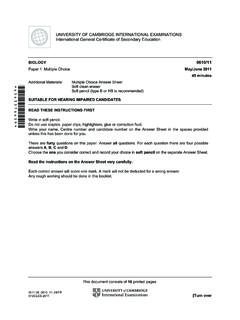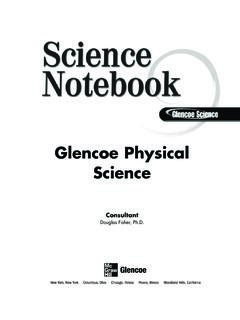Transcription of 0652 PHYSICAL SCIENCE - GCE Guide
1 CAMBRIDGE INTERNATIONAL EXAMINATIONS. International General Certificate of Secondary Education MARK SCHEME for the October/November 2012 series 0652 physical science . 0652/31 paper 3 (Extended Theory), maximum raw mark 80. This mark scheme is published as an aid to teachers and candidates, to indicate the requirements of the examination. It shows the basis on which Examiners were instructed to award marks. It does not indicate the details of the discussions that took place at an Examiners' meeting before marking began, which would have considered the acceptability of alternative answers. Mark schemes should be read in conjunction with the question paper and the Principal Examiner Report for Teachers. Cambridge will not enter into discussions about these mark schemes. Cambridge is publishing the mark schemes for the October/November 2012 series for most IGCSE, GCE Advanced Level and Advanced Subsidiary Level components and some Ordinary Level components. Page 2 Mark Scheme Syllabus paper IGCSE October/November 2012 0652 31.
2 1 (a) (i) expansion ; [1]. (ii) 0 C and 100 C ; [1]. (iii) distance from 0 100 marks = = cm ;. length of column from 0 mark = = cm ;. temperature = / 100 ;. = 67 C ; [4]. (b) (i) the smallest temperature change which can be measured / change in property per unit temperature change ; [1]. (ii) narrower tube / larger bulb / use liquid which expands more (per unit temperature change (accept thinner capillary tube but must have capillary) ; [1]. (c) thermoelectric effect / change of colour of crystals / expansion or pressure of gases or solids / electrical resistance / bimetal effect / other ; [1]. [Total: 9]. 2 (a) (i) (high) melting point / two electrons in outer shell ; [1]. (treat high density as neutral). (ii) each has two / same number of electrons in outer shell ;. atomic number goes up by 8 between each one / extra shell each time ; [2]. (iii) identify density ;. decreases with increase in atomic number / down group or vice versa ; [2]. (b) MgCl 2 ; (accept ionic formula but charges must be correct) [1].)
3 (c) metal has (lattice of) positive ions (accept atoms / particles but must be positive) ;. in sea of / delocalised / free electrons ;. layers move easily (to allow bending) ; [3]. (accept diagrams with suitable labelling, for all 3 marks). [Total: 9]. 3 (a) the point at which the whole mass of a body may be considered to act ;; [2]. (max 1 for use of weight and / or stating the mass is at that point). (b) (i) W = mg (= 10) = N ; [1]. (ii) distance = (m) ;. moment = (Nm) ; [2]. (iii) (Nm) or x ; [1]. Cambridge International Examinations 2012. Page 3 Mark Scheme Syllabus paper IGCSE October/November 2012 0652 31. (iv) = x ;. x = m ; [2]. [Total: 8]. 4 (a) dissolve both in water and mix (accept react / put together as 0 marks qualifies for other marks) ;. filter (off precipitate) ;. wash residue with (distilled / deionised) water ;. leave to dry / dry in oven ; [4]. (b) (i) Ca(NO3)2(aq) + Na2SO4(aq) CaSO4(s) + 2 NaNO3(aq) ;;;. (1 mark each for: formulae ; balance ; state symbols ;) [3].
4 (ii) relative formula mass of CaCl2 = 111 ;. CaSO4 = 136 ;. mass calcium sulfate = (136 / 111) 5 (= ) (ignore extra significant figures /. rounding errors) ; [3]. [Total: 10]. 5 (a) (i) straight line so that light is bent towards the normal ; [1]. (ii) use of n = sin i / sin r ;. = sin 45 / sin 30 ;. = ; [3]. (iii) straight line so that light is bent away from the normal ; [1]. (b) correct refraction at 1st face and ray above the blue ray in the prism ;. correct refraction at 2nd face, emergent rays diverging (even if red refracted more throughout) ; [2]. (if rays only separate at 2nd face, max 1 mark). [Total: 7]. 6 (a) (i) calcium, magnesium, zinc, iron ; (must be this order) [1]. (ii) no reaction / no bubbles observed (accept very little reaction) ; [1]. (iii) takes longer / slower reaction (to get 100 cm 3 hydrogen) ; [1]. (b) (i) number of moles of H2 = 180 / 24000 (180 / 24 = 0) ;. (relative formula mass HCl = ), so two moles = 73 g ;. mass of hydrogen chloride = 73 180 / 24000 (= g).
5 (answer of gains all 3 marks, (4) gains 2 marks) [3]. (ii) mass per dm3 = 1000 / 100 = g ;. concentration = / = mol / dm3 ; [2]. [Total: 8]. Cambridge International Examinations 2012. Page 4 Mark Scheme Syllabus paper IGCSE October/November 2012 0652 31. 7 (a) total work done by unit charge as it moves round a complete circuit / energy gained by unit charge as it moves through a power supply ;. (accept voltage when energy is given by a battery / generator and potential difference across the terminals when zero current taken) [1]. (b) (i) use of power = VI (= ) ;. = W [2]. (ii) use of Q = It ( = 51 3600) ;. = 3700 C (precise - 3672) ; [2]. (iii) use of W = VQ or VIt or Pt (= 3700) ;. = 13600 J (precise 13586 or 13690 accept 13700) ; [2]. (c) part of the electromagnetic spectrum ;. between radio and infra red / (very) high frequency / short wavelength radio ; [2]. (accept wavelengths between 1 mm and 1000 mm and relevant frequencies). [Total: 9]. 8 (a) steel / iron will rust / react/oxidises (in contact with oxygen and water / food).
6 Tin does not react / corrode / is low reactivity ;. aluminium forms has oxide layer ;. which seals / acts as a barrier to the aluminium (from water and oxygen) ; [4]. (b) (i) low density ;. (ii) pure aluminium has (layers of) same size ions ;. alloy has ions of different sizes ;. aluminium layers slide easily over each other / prevents movement of layers /. owtte ; [3]. [Total: 8]. 9 (a) slip ring ;. brush ; [2]. (b) conductor moves or rotates / magnets move ;. cutting / changing magnetic field / flux ; (accept field lines). induces / voltage / current across / through the output circuit ; [3]. (c) (i) to rectify the output / change output from to / owtte ; [1]. (ii) either bottom or top loops cut off (ignore changes in period / amplitude) ; [1]. [Total: 7]. Cambridge International Examinations 2012. Page 5 Mark Scheme Syllabus paper IGCSE October/November 2012 0652 31. 10 (a) in exothermic reaction energy is given out (as heat) ;. (accept idea that energy is released in reaction even if the process is wrong).
7 Energy is released when new bonds are made or used when old bonds are broken ;. correct comparison of making / breaking bonds ; [3]. (b) fermentation / addition of steam to / hydration of ethene ; [1]. (c) solvent / in beverages / sterilisation / disinfectant / antiseptic / making esters / fat test ; [max 1]. [Total: 5]. Cambridge International Examinations 2012.
















